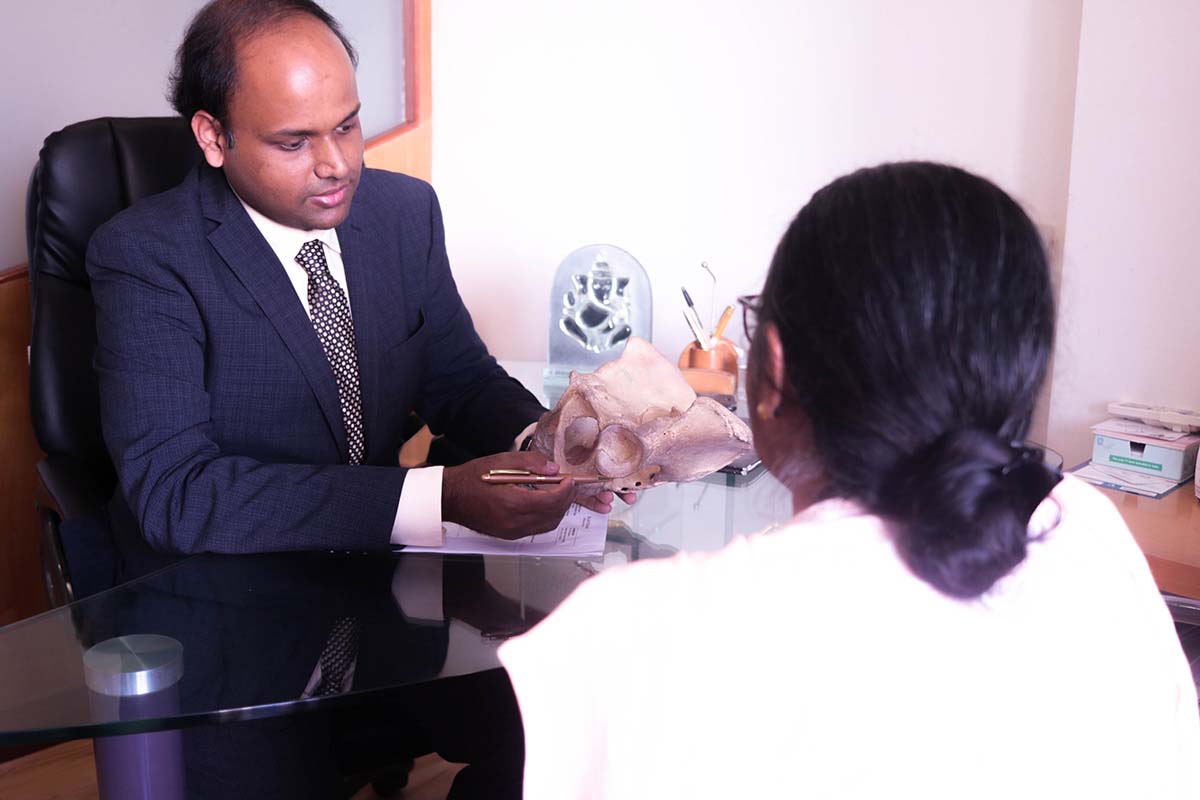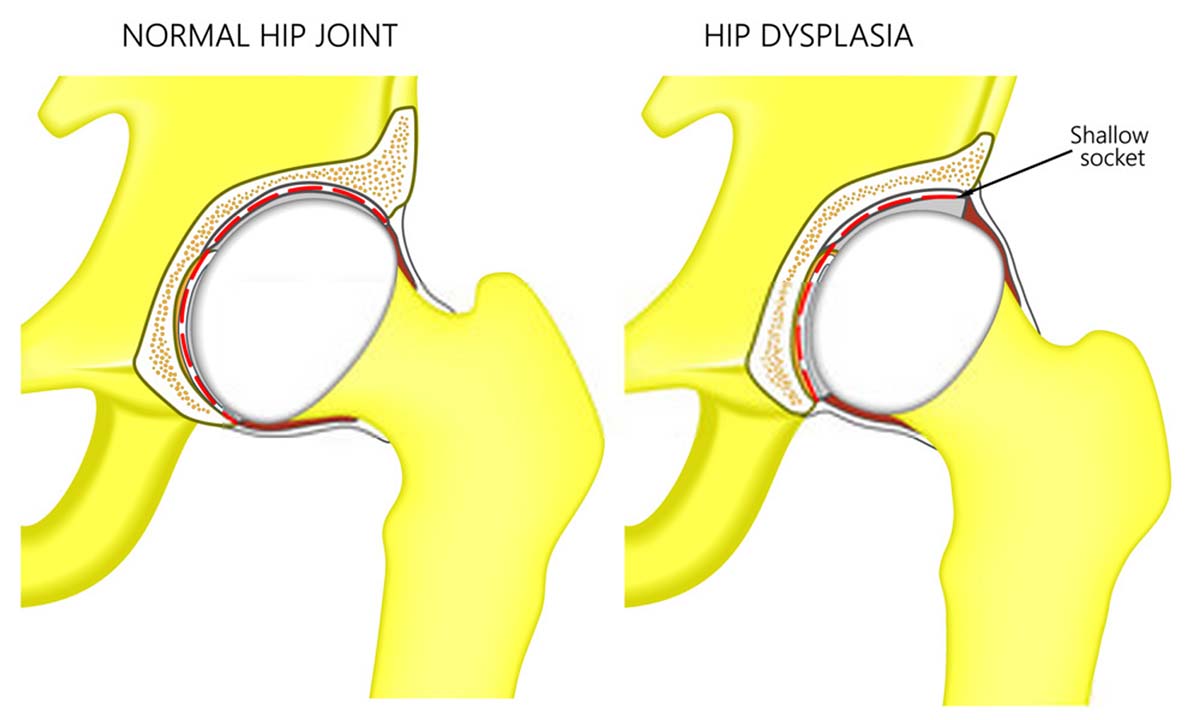
The hip joint is the largest joint of the human body. It is a ball and socket joint. The thigh bone (femur) ends with a rounded projection or ball (femoral head), which fits into the socket (acetabulum) of the pelvic girdle. Both the ball and socket are lined with cushioning tissue called cartilage.
The joint is sealed inside a tough capsule made of membrane (synovial capsule), which contains lubricating fluid that aids smooth motion of the joint. The ball is anchored firmly into the socket with tough connective tissue called ligaments. The muscles of the legs overlay these ligaments.
The hip joint is complicated so as to allow a wide range of motion while still supporting the weight of the body.

Osteoarthritis is associated with degeneration of the joint cartilage and with changes in the bones underlying the joint. The cartilage becomes brittle and splits. Some pieces may break away and float around inside the synovial fluid within the joint. This can lead to inflammation.
Eventually, the cartilage can break down so much that it no longer cushions the two bones. Current theory suggests that the cartilage loses its elasticity because of cellular changes. Commonly affected joints include those of the hip, spine, shoulder, fingers, knees, ankles, feet and toes.
Types: Primary OA (Idiopathic), Secondary OA
Causes of Secondary OA:
Nonsurgical treatment: Activity modifications, Physical therapy, Medications (eg NSAID’s), Assistive walking aids.
Surgical treatment: Total Hip Replacement
A painful hip condition due to disruption of the blood supply to the head of femur, ultimately leading to destruction of femoral head and osteoarthritis.
Risk factors: Injury to the hip, Excessive alcohol consumption, Corticosteroid therapy, certain blood disorders.
Treatment depends on the stage at diagnoses. In early stages hip preservation procedures can be carried out such as Core Decompression with or without bone grafting. In later stages (especially after head collapse) Total Hip Replacement is the recommended.
FAI is a condition in which abnormal bone growth occurs over the femoral head and/or along the acetabulum. Due to this there is abnormal contact during hip movement eliciting pain and prevents smooth movement. In due course this can lead to labral tears and hip osteoarthritis. Symptoms include pain, stiffness, occasional limp.
3 types of FAI: Pincer (extra bone along acetabulum), Cam (Extra bone along edge of femoral head) & Combined.
Treatment: Non Surgical – NSAID’s, Activity modification and physical therapy.
Surgical (currently the gold standard) – Arthroscopy of the hip or Open hip surgery.
Rheumatoid arthritis is an immune condition that causes inflammation in moving joints (synovial joints).
Although people who develop rheumatoid arthritis may have a predisposition to the condition, the ‘trigger’ for developing symptoms is unknown.
Inflammation in joints results in an increase in synovial fluid (swelling of the joint), pain and morning joint stiffness. Joints that can be affected include those of the hands and wrists, elbows, shoulders, neck, jaw, hips, knees, ankles and feet.
This uncommon form of inflammatory arthritis can target the spine, knees and hips. Typical symptoms include pain and stiffness first thing in the morning. The cause is unknown, but genes are thought to play a significant role.
Ankylosing spondylitis can occur by itself or in association with other disorders, including Crohn’s disease, ulcerative colitis and psoriasis. Caucasian men aged between 16 and 33 years are most susceptible.
Non Surgical Treatments: Includes NSAID’s, Steroids, DMARD’s, Physical Therapy, Waling aids.
Surgical Treatment: Total Hip Replacement will be required when symptoms persist despite medications late in the disease.
Older people are more prone to hip fractures because bones become less dense as we age. In some cases, a person develops osteoporosis – a disease characterised by the excessive loss of bone tissue. The bones become soft and brittle, and prone to fractures and deformities. More women than men experience osteoporosis.
Developmental dysplasia of the hip means that the hip joint of a newborn baby is dislocated or prone to dislocation. The socket is abnormally shallow, which prevents a stable fit. Slack ligaments may also allow the femoral head to slip out of joint.
As the child grows and becomes an adolescent and young adult, the dysplasia of the hip can become symptomatic. Treatment at this stage is usually in the form of acetabular osteotomy, femoral osteotomy or both.

Possible causes include a breech delivery, family history and disorders such as spina bifida. Around 95 per cent of babies born with developmental dysplasia of the hip can be successfully treated.
The labrum is a protective cartilaginous structure over the rim of the acetabulum. It serves to deepen the socket and prevents against joint injuries. The Labrum may tear due to trauma or FAI or in dysplastic hips.
Labral injury will usually require surgical treatment in the form of debridement, repair or reconstruction usually via hip arthroscopy.
These include:
Treatment for most of these conditions is usually conservative which includes injections around the hip, medications and physical therapy. In event of poor response to non surgical management or recurrent symptoms arthroscopy hip surgery can be performed to alleviate symptoms.
Perthes’ disease is a disease of the hip joint. It tends to affect children between the ages of three and 11 years. The ball of the femur is softened, and ultimately damaged, due to an inadequate blood supply to the bone cells.
Most children with Perthes’ disease eventually recover, but it can take anywhere from two to five years for the femoral head to regenerate. The cause is unknown.
During childhood, the femoral ball is attached to the femur with a growth plate of bone. In some teenagers, the ball can slide from its proper position, causing the leg on the affected side to turn out from the body.
Possible contributing factors include the shape and location of the femoral head in relation to the femur, increased sex hormones during puberty, and weight gain. Without treatment, slipped capital femoral epiphysis will worsen and the child may experience arthritis of the hip joint in later life.
Irritable hip syndrome (sometimes called toxic synovitis) is a temporary form of arthritis, which tends to affect prepubescent children for unknown reasons. Boys with toxic synovitis outnumber girls four to one. Symptoms include hip pain (usually on one side only), inability to walk (or limping), knee pain and fever. Most cases of toxic synovitis resolve by themselves within one or two weeks.